Ensuring healthy edible oil consumption: Part I(a) Estimating each family member’s actual consumption
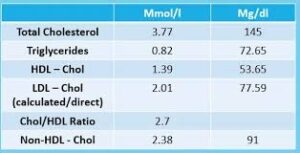
The utility of even approximate individual oil consumption: Expectedly, it is difficult to accurately calculate consumption of oils in terms of quantities by individual members of the family. Undaunted, we have worked out the modalities of closely estimating it given its importance. Oil/fat consumption is an important dietary determinant of an individual’s physiological-analytical parameters like the blood lipid profile, externally observed features like BMI and felt experiences like agility or lethargy. These, in turn, can be strong predictors of serious conditions like obesity, cancers, diabetes, cardiovascular disease and many more. (Refer posts 21 thru 30).
In other words, individual oil consumption, physiological parameters and experienced wellness are interconnected and the first happens to be controllable. Thus, modalities of estimating quantities consumed by individual family members cannot be abandoned just because they cannot be mathematically accurate. A reasoned exercise to do this would thus be a tangible contribution to wellness.
We will now divide our oil consumption into two most logical and mutually exclusive parts: at home and away from home.
- OIL/FAT CONSUMPTION BY INDIVIDUALS AT HOME
(Ref post no. 17, Edible oils, an introduction, to know why the oil/fat distinction is superfluous.)
Versions of oil consumption at home: As already noted, our oil consumption is usually indirect and in three forms:
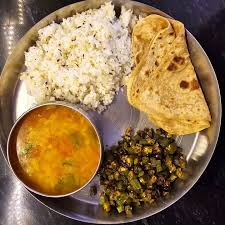 (i) As home-cooked food: We hardly notice that at home, packaged oil is brought and gradually disappears in the form of eaten dishes. (Ref post nos. 31 and 32, How we use edible oils for cooking: Parts I & II). Being observable as reduction in kitchen’s oil stocks, it is visible consumption and obviously estimable (as ‘-∆s’) for the family as a whole. Obviously, it has to be apportioned to individual members to arrive at individual visible oil consumption at home.
(i) As home-cooked food: We hardly notice that at home, packaged oil is brought and gradually disappears in the form of eaten dishes. (Ref post nos. 31 and 32, How we use edible oils for cooking: Parts I & II). Being observable as reduction in kitchen’s oil stocks, it is visible consumption and obviously estimable (as ‘-∆s’) for the family as a whole. Obviously, it has to be apportioned to individual members to arrive at individual visible oil consumption at home.
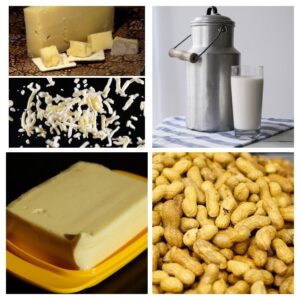 (ii) As consumption of uncooked oily/fatty foods like milk, butter, cheese, nuts. Individual consumptions of specific oily/fatty foods (mi) are difficult to track and, for that consumption, the oil-contents (ci) are not known. Hence, individual invisible oil consumptions at home (mi.ci) thru oily/fatty natural foods are difficult to track.
(ii) As consumption of uncooked oily/fatty foods like milk, butter, cheese, nuts. Individual consumptions of specific oily/fatty foods (mi) are difficult to track and, for that consumption, the oil-contents (ci) are not known. Hence, individual invisible oil consumptions at home (mi.ci) thru oily/fatty natural foods are difficult to track.
 (iii) As bought-outs consumed at home e.g. fried snacks and namkeen, biscuits and cookies, ice-creams and kulfi, ordered dishes like pizza and burgers. Again, this invisible oil consumption thru cooked/processed foods brought home, is difficult to estimate for individuals.
(iii) As bought-outs consumed at home e.g. fried snacks and namkeen, biscuits and cookies, ice-creams and kulfi, ordered dishes like pizza and burgers. Again, this invisible oil consumption thru cooked/processed foods brought home, is difficult to estimate for individuals.
Daunting, isn’t it?
Individual total oil consumption at home: It is obviously (i) + (ii) + (iii) when apportioned logically.
Now let us delve into the details.
Visible oil consumption at home (i): That home-cooked food intake of each family member is different is obvious and it applies to oil-carrying dishes also. Thus someone preferring ghee on his roti and in his rice and partial to fried items like pakoda and puri is likely to consume more oil than average; significantly more if he is a ‘big eater’. Understandably, this type is the most vulnerable to obesity for starters. Since this is the largest component of oil consumption, the apportionment of the total to individuals is important but it will have to be the home-maker’s ‘judgement’ or ‘gut feel’ which can be astonishingly effective.
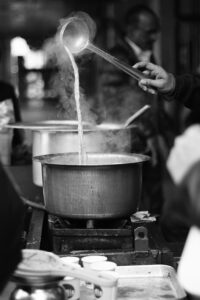 (A side note: I love to ‘judge’ – and not measure in spoonfuls/cups – amounts of water, sugar, tea leaves, milk and ginger/special tea spice for morning’s 1, 2 or 3 cups of tea; it depends on who is up and who is not. That has been my unwavering morning ritual for decades. The level of liquid in the cylindrical pot that you are used to make tea, the size of the ‘funnel’ of tea leaves and sugar as they are poured into the palm of your hand from their respective containers, the volume of the ginger piece and the particle spread of tea spice on the liquid are amazing indicators of quantity. For us, two cups of tea need three ‘funnels’ of sugar and two of tea leaves; it helps that we have standardized our ‘grades’ for both.
(A side note: I love to ‘judge’ – and not measure in spoonfuls/cups – amounts of water, sugar, tea leaves, milk and ginger/special tea spice for morning’s 1, 2 or 3 cups of tea; it depends on who is up and who is not. That has been my unwavering morning ritual for decades. The level of liquid in the cylindrical pot that you are used to make tea, the size of the ‘funnel’ of tea leaves and sugar as they are poured into the palm of your hand from their respective containers, the volume of the ginger piece and the particle spread of tea spice on the liquid are amazing indicators of quantity. For us, two cups of tea need three ‘funnels’ of sugar and two of tea leaves; it helps that we have standardized our ‘grades’ for both.
It is one of my favorite themes: we always have a lot more than we think; don’t be instinctively paralysed by insufficient or flawed data or lack of tools, especially when the approximation is unlikely to lead to life-changing outcomes. It helps hone a skill that is thrilling and useful. In another post, I have already described how we can roast spices in a wok, stirring by fingers as an automatic sensorial control that will prevent localized heating or general overheating. Let’s pay homage here to last year’s Nobel winners in physiology who explained how we sense temperature by touch. You already know both the need for roasting and its control to minimize oxidatively abused constituents entering our body. I admire people who cook in the jungle on wood-fire within a brick arrangement, with nothing but ingredients. Any doubts that they can do the same in a spacious, equipped kitchen?)
The details of how visible oil consumption (to be apportioned by the home maker) can be calculated quite accurately for a month or year (∆t) is a part of the next Part b of this post. Thus Geeta, having calculated that her family consumed 50 kgs of bought-out oil last year, can decide that the individual visible home consumptions were:
Ramesh, her 30 BMI husband, (age 50)……14 kgs
Herself, a working woman, who takes the stairs (age 45)…………12 kgs
Her son, Yatin, a sportsy student (age 20) ………………………………14 kgs
Her weigh-watcher danseuse daughter, Reema (age 18)……………10 kgs
If Ramesh derides Geeta for her ‘airy fairy approximations’ and continues his fattening ways, he deserves what is coming to him. (Meet Geeta and Ramesh in post no. 11, Indian consumer and Processed Foods.)
Invisible oil consumption at home thru natural foods (ii): We hardly notice that non-negligible amounts of oils enter our body at home thru consumption of milk, butter, cheese and nuts. (Note: even fruits and vegetables contain traces of ‘invisible oils’.) Obviously, their contribution to consumption at home is directly proportional to quantities consumed and the oil content of each item. For convenience, milk, butter, nuts, and ghee can be treated as having 5%, 80%, 50% and 100% oil/fat. The quantities consumed are the home-maker’s prerogative to determine; she is in a position to judge fairly accurately.
Geeta’s yearly ‘allotments’ of invisible oil consumption at home thru naturals:
Ramesh…2.0 kgs, Herself…1.5 kgs, Yatin…3.0 kgs (he is fond of milk, lassi, matthas and nuts), Reema…1.5 kgs (cheese is her weakness, butter, ghee, she avoids).
Invisible oil consumption at home thru bought-outs (iii): Over the last 10 years, occasional ‘bringing home’ of vada pao, samosa, biscuits, ice-creams and kulfi’s, namkeens and wafers, pizza and burgers etc. as occasional ‘treats’ brought home, has not only increased but has also been joined by ‘ordering from home’. Added to this alarming trend is the delivery of cooked dishes – a seductive escape for supposedly harassed and short-on-time home makers.
That companies delivering cooked food have persisted despite prolonged cash-burn and consistently red bottomlines is testimony to their faith in their ‘value proposition’ which is continuing to be supported by all shades of ‘venture funds’. Zomato’s stunning and obviously expensive recent TVC campaign to ‘fuel your hustle’ with a ‘secret sauce’ bears this optimism out. (Personally, I loved it for both planning and execution.) Ordering cooked food for home is not going anywhere except up. Obviously, for that ordered meal, cooking oil tin/bottle/can at home is not touched. This makes accompanying oil/fat consumption invisible. Apart from being potentially risky given the unknown antecedents of the food.
(Note: 1. Watch Geeta maximize the utility of a small ready-to-eat bought-out in post no. 11: Indian consumer and processed foods.)
-
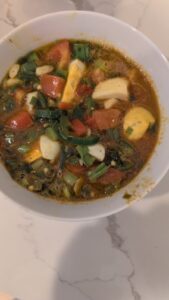 Meet Ananya in ‘About us’. He is an ‘ideal’ customer for such ready-to-eats because of his demanding research schedule. But he is a rare customer; he has perfected some single-dish home-cooked meals – sometimes supported by preservatives-free sliced bread-that are proteinaceous, fibrous and tasty enough to support his vigorous work-outs. So, ‘I have no time’ is hollow in most cases.
Meet Ananya in ‘About us’. He is an ‘ideal’ customer for such ready-to-eats because of his demanding research schedule. But he is a rare customer; he has perfected some single-dish home-cooked meals – sometimes supported by preservatives-free sliced bread-that are proteinaceous, fibrous and tasty enough to support his vigorous work-outs. So, ‘I have no time’ is hollow in most cases. - Allotment of invisible oil consumption to this category would be practically nil for us Trivedi’s.
Geeta, as a working woman, allows an allotment of uniform 1 kg for each member as a ‘ball park’ figure.
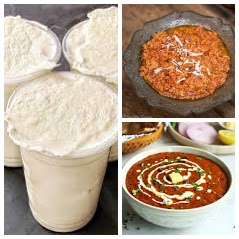 (Interestingly, ordered dishes, whether consumed at home or away, seem to favor higher oil/fat levels in dishes. The oil-dripping subji dishes, winter tonic sweets with solidified ghee on the top surface, lassi – ‘malai maarke’ and ‘butter’ slapped into bhaji (of the pao bhaji fame) on the hot plate are some examples.
(Interestingly, ordered dishes, whether consumed at home or away, seem to favor higher oil/fat levels in dishes. The oil-dripping subji dishes, winter tonic sweets with solidified ghee on the top surface, lassi – ‘malai maarke’ and ‘butter’ slapped into bhaji (of the pao bhaji fame) on the hot plate are some examples.
We Trivedi’s aspire to some day visit Kesar da Dhaba in Amrtisar (Punjab) for their criminally oily/fatty naans, halwas, daals and subjies just to be able to say that we can conform also. But note how we are smartly defering ‘conforming’ to some undefined time in the future!). Somehow, such extra oiliness adds ‘special appeal’ or ‘richness’ to the offerings and obesity–tending consumers instinctively reach out for such dishes. Ref post nos. 23 and 24, Obesity – the accumulation of the unused: Parts III and IV.
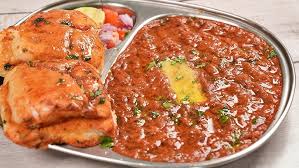 Equally interestingly, most of the oil in bought-outs is palm oil and palmolein – technically good for most uses – and the cost structure of offering those dishes is such that generous use of oils actually reduces cost/kg. Let us not comment on those claiming use of ‘shuddha ghee’ in cooking. Thus the extra appeal of an oil-rich dish works ‘cost-effectively’. Also not all ‘butter’ slapped into the bhaji is dairy butter; it is often margarine made mostly from the same favorites – palm oil and palmolein. Most large cities have margarine making small businesses to cater to the small scale pao bhaji, sandwiches and maska-pao wallahs – a special and unnoticed segment, ‘SB to SB’ of ‘B to B’!)
Equally interestingly, most of the oil in bought-outs is palm oil and palmolein – technically good for most uses – and the cost structure of offering those dishes is such that generous use of oils actually reduces cost/kg. Let us not comment on those claiming use of ‘shuddha ghee’ in cooking. Thus the extra appeal of an oil-rich dish works ‘cost-effectively’. Also not all ‘butter’ slapped into the bhaji is dairy butter; it is often margarine made mostly from the same favorites – palm oil and palmolein. Most large cities have margarine making small businesses to cater to the small scale pao bhaji, sandwiches and maska-pao wallahs – a special and unnoticed segment, ‘SB to SB’ of ‘B to B’!)
Summary: Total ‘at home’ consumption of oils for Geeta’s family:
Ramesh : 14.0 + 2.0 + 1.0 = 17.0 kgs.
Geeta : 12.0 + 1.5 + 1.0 = 14.5 kgs.
Yatin : 14.0 + 3.0 + 1.0 = 18.0 kgs.
Reema : 10.0 + 1.5 + 1.0 = 12.5 kgs.
Total = 62 kgs
Note: (i) Geeta poured out only 50 kgs. (visible) throughout the year from her tins/bottles/cans. We Trivedi’s pour out more than this and there are only three of us here; Ananya is away in the US. (See ‘About us’). But we are still fine; the devil is in the detail. More about it, later. (ii) The ‘at home’ visible/invisible ratios are, respectively, 4.67, 4.8, 3.5, 4.0, seemingly without a pattern. However, Yatin’s poor ratio stems from his preference for nuts – a healthy way to supply calories for his sportsy life. Ramesh is flawed in high visible consumption for his lifestyle and his invisible consumption of 3.0 is less healthy than Yatin’s 4.0.)
All four have significant outdoor life and hence non-negligible outside oil consumption – obviously of the invisible type. In each case, it would obviously be the summation of the products of (number of eating events) and (oil/fat content of each). Its best possible approximation would be to treat it as a % of home consumption i.e. (a factor ‘f’)*(total individual home consumption).
Thus total individual oil consumption = (1 + f)*( total home consumption) = (1 + f)*( i + ii + iii) where 0<f<1. Let’s take it up now.
- OIL CONSUMPTION BY INDIVIDUALS AWAY FROM HOME
Increasing oil consumption away from home: Phenomena like globalization, economic growth, population increase and accompanying need and competition for resources, access to fruits of science and technology, access to information which stokes aspirations etc. have changed our social and professional lives – always intertwined – a lot.
 The market, always breathing down the necks of aspiring consumers, has spawned a mind-boggling variety of ‘convenience’ products and services: packaged ready-to-eats, orderable ready-to-eats, professional caterers delivering packages or ‘tiffins’ to work places, ‘industrial kitchens’ serving cooked food ‘in house’ during working hours, a variety of specialty restaurants serving Italian, Chinese, Mediterranian, Punjabi-Mughalai, South Indian food, sprawling street-food kiosks….…. luring people for lunches during working hours and dinners during afterhours.
The market, always breathing down the necks of aspiring consumers, has spawned a mind-boggling variety of ‘convenience’ products and services: packaged ready-to-eats, orderable ready-to-eats, professional caterers delivering packages or ‘tiffins’ to work places, ‘industrial kitchens’ serving cooked food ‘in house’ during working hours, a variety of specialty restaurants serving Italian, Chinese, Mediterranian, Punjabi-Mughalai, South Indian food, sprawling street-food kiosks….…. luring people for lunches during working hours and dinners during afterhours.
‘Who has the time to cook at home or the inclination to learn’ is supported by rising incomes – often multiple ones in a family. Irrespective of the validity or otherwise of such an attitude, it is a reality that is promoting significant oil consumption away from home, especially in large cities teeming with ‘driven’ and ‘fun-loving’ people. This important component of our oil consumption has remained astonishingly unnoticed. That such oil is likely to be of spurious quality to begin with and abused oxidatively during cooking is rarely noticed – a curious case of passion for life leading to spurious lifestyle. (Ref post nos. 16 and 18, Oxygen, food and life : Part II, and Edible oils have many roles outside our body.)
Small-towners often visit the nearby ‘city’ for purchase of personal/business needs or for visiting relatives and professional/government offices and such visits are a great opportunity to have lunch at ‘that lovely Punjabi-Chinese’ place or enjoy a kulfi/lassi at that place near the station. I say this from personal experience and observation.
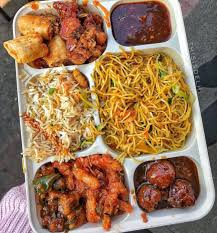 We Trivedi’s spent 18 delightful months at a small town near Gandhinagar (Gujarat, India) and ‘frequented’ (by our standards; actually about 5 times in 18 months) a restaurant that served an amazing ‘Chinese platter’ that the three of us relished and could share. That was 7 years ago; since then we have often wanted to go there ‘for old time’s sake’. We have actually not been able to do it even once. It obviously releases family time at home. Did we lose out on justifiable pleasure? Why could we not manage even one easy visit? Our cost-benefit? You decide.
We Trivedi’s spent 18 delightful months at a small town near Gandhinagar (Gujarat, India) and ‘frequented’ (by our standards; actually about 5 times in 18 months) a restaurant that served an amazing ‘Chinese platter’ that the three of us relished and could share. That was 7 years ago; since then we have often wanted to go there ‘for old time’s sake’. We have actually not been able to do it even once. It obviously releases family time at home. Did we lose out on justifiable pleasure? Why could we not manage even one easy visit? Our cost-benefit? You decide.
Judging individual oil consumption away from home: As already hinted in this post, individual member’s oil consumption away from home = f(i + ii + iii), hence total consumption = ( 1 + f)( i + ii + iii). For f = 0.05,
Ramesh : 17.85, Geeta : 15.23, Yatin = 18.9, Reema = 13.13.
As we will soon see, they are not doing too badly in terms of quantities. Let us now complete the quantity consumption by addressing the remaining issues.
Next Post:
Ensuring healthy edible oil consumption : Part I(b)
The remaining miscellaneous aspects of oil consumption
Visit Disclaimer